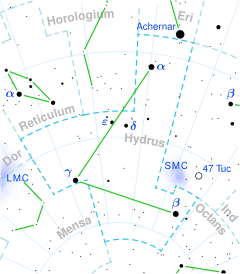Beta Hydri
| Observation data Epoch J2000 Equinox J2000 | |
|---|---|
| Constellation | Hydrus |
| Right ascension | 00h 25m 45.07036s[1] |
| Declination | –77° 15′ 15.2860″[1] |
| Apparent magnitude (V) | 2.80[2] |
| Characteristics | |
| Spectral type | G2 IV[3] |
| U−B color index | +0.11[2] |
| B−V color index | +0.62[2] |
| Absolute magnitude (MV) | 3.45 ± 0.01[5] |
| Details | |
Gyr | |
FK5 11, LPM 22, LFT 43. | |
| Database references | |
| SIMBAD | data |
Beta Hydri (β Hyi, β Hydri) is a
This star has about 104% of the mass of the Sun and 181% of the Sun's radius, with more than three times the Sun's luminosity.
At a distance of 13°, it is the closest easily visible star to the south
Search for planets
In 2002, Endl et al. inferred the possible presence of an unseen companion orbiting Beta Hydri as hinted by radial velocity linear trend with a periodicity exceeding 20 years. A substellar object such as a planet with a minimum mass of 4 Jupiter masses and orbital separation of roughly 8 AU could explain the observed trend.[8] If confirmed, it would be a true Jupiter-analogue, though 4 times more massive. So far no planetary/substellar object has been certainly detected.
These results were not confirmed in CES and HARPS measurements published on the arXiv in 2012. Instead the long-term radial velocity variations may be caused by the star's magnetic cycle.[9]
See also
References
- ^ S2CID 18759600
- ^ Bibcode:1966CoLPL...4...99J
- ^ S2CID 37441284
- S2CID 11027621
- ^ S2CID 9341088
- Bibcode:2000A&A...361..614P
- ^ "Beta Hydri".
- S2CID 17393347.
- S2CID 53694238.
External links
- "Beta Hydri". SolStation. Retrieved November 3, 2005.
- "Beta Hydri". Dr. Jim Kaler. Archived from the original on December 10, 2005. Retrieved March 15, 2005.
- Stellar Activity - Beta Hydri

